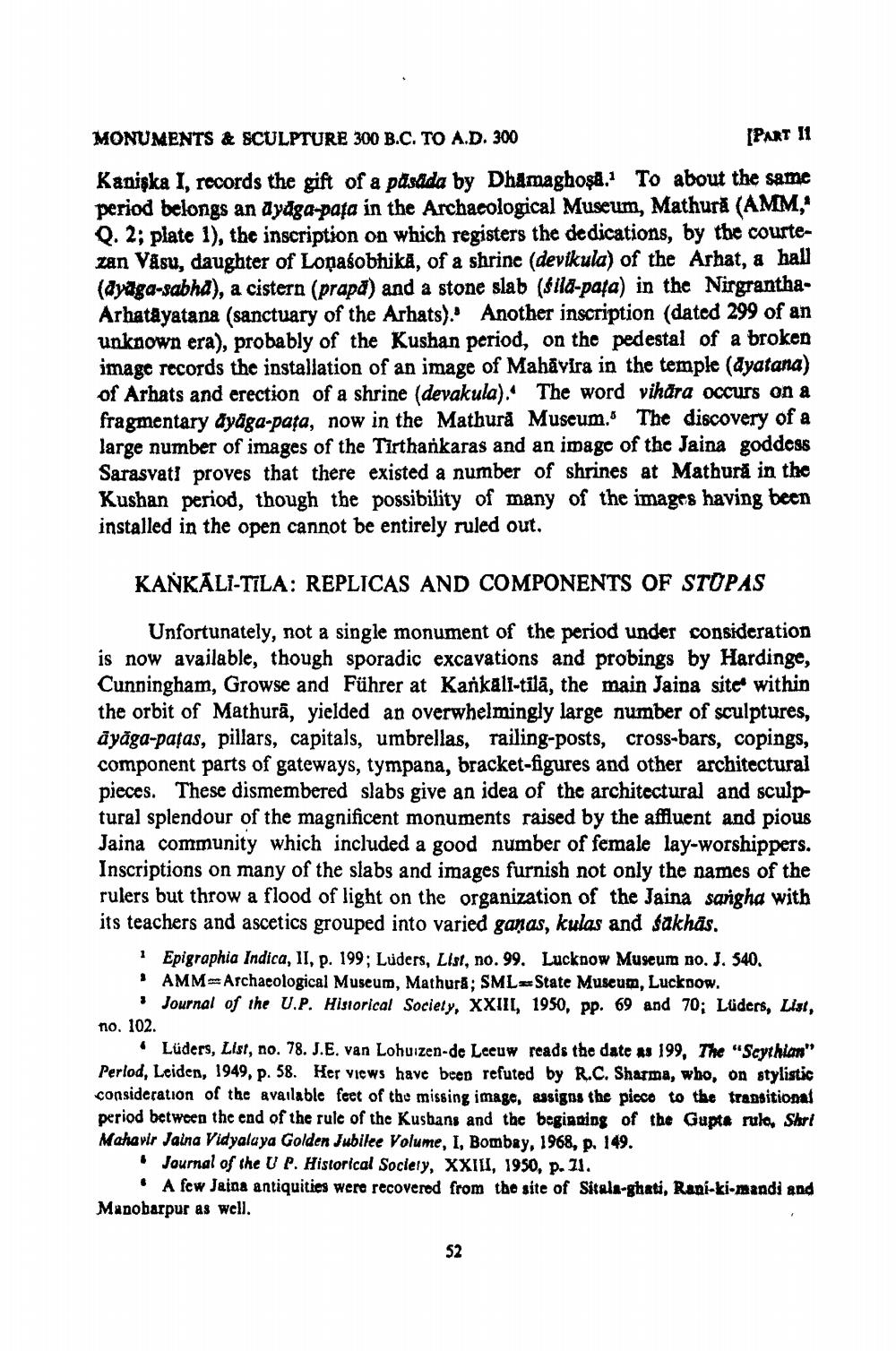________________
MONUMENTS & SCULPTURE 300 B.C. TO A.D. 300
[PART 11
Kaniska I, records the gift of a pasada by Dhamaghoşă. To about the same period belongs an dydga-pata in the Archacological Museum, Mathura (AMM, Q. 2; plate 1), the inscription on which registers the dedications, by the courtezan Väsu, daughter of Loņasobhika, of a shrine (devikula) of the Arhat, a hall (dyaga-sabha), a cistern (prapa) and a stone slab (slla-paļa) in the NirgranthaArhatāyatana (sanctuary of the Arhats)! Another inscription (dated 299 of an unknown era), probably of the Kushan period, on the pedestal of a broken image records the installation of an image of Mahavira in the temple (dyatana) of Arhats and erection of a shrine (devakula). The word vihara occurs on a fragmentary dyaga-pata, now in the Mathura Museum. The discovery of a large number of images of the Tirthankaras and an image of the Jaina goddess Sarasvati proves that there existed a number of shrines at Mathură in the Kushan period, though the possibility of many of the images having been installed in the open cannot be entirely ruled out.
KANKĀLI-TILA: REPLICAS AND COMPONENTS OF STUPAS
Unfortunately, not a single monument of the period under consideration is now available, though sporadic excavations and probings by Hardinge, Cunningham, Growse and Führer at Kankali-tilā, the main Jaina site within the orbit of Mathurā, yielded an overwhelmingly large number of sculptures, āyāga-pațas, pillars, capitals, umbrellas, railing-posts, cross-bars, copings, component parts of gateways, tympana, bracket-figures and other architectural pieces. These dismembered slabs give an idea of the architectural and sculptural splendour of the magnificent monuments raised by the affluent and pious Jaina community which included a good number of female lay-worshippers. Inscriptions on many of the slabs and images furnish not only the names of the rulers but throw a flood of light on the organization of the Jaina sangha with its teachers and ascetics grouped into varied ganas, kulas and sakhas.
Epigraphia Indica, II, p. 199; Luders, List, no. 99. Lucknow Museum no. J. 540. I AMMArchaeological Museum, Mathura: SML State Museum, Lucknow.
• Journal of the U.P. Historical Society, XXIII, 1950, pp. 69 and 70; Lüders, Llat, no. 102.
Lüders, List, no. 78. J.E. van Lohuizen-de Leeuw reads the date as 199, The "Scythian" Perlod, Leiden, 1949, p. 58. Her views have been refuted by R.C. Sharma, who, on stylistic consideration of the available feet of the missing image, assigns the picco to the transitional period between the end of the rule of the Kusbans and the beginning of the Gupta rulo, Shri Mahavir Jaina Vidyalaya Golden Jubilee Volume, I, Bombay, 1968, p. 149.
Journal of the U P. Historical Society, XXIII, 1950, p.71.
• A few Jaina antiquities were recovered from the site of Sitala-ghati, Rani-ki-mandi and Mudobarpur as well.




